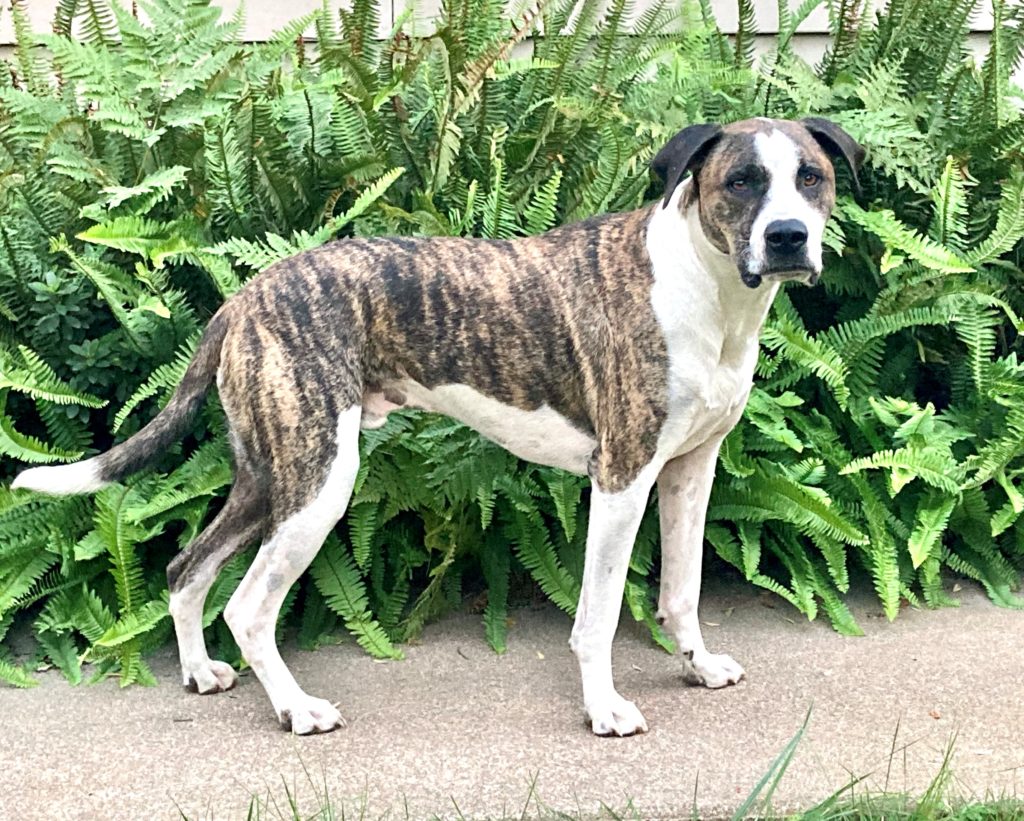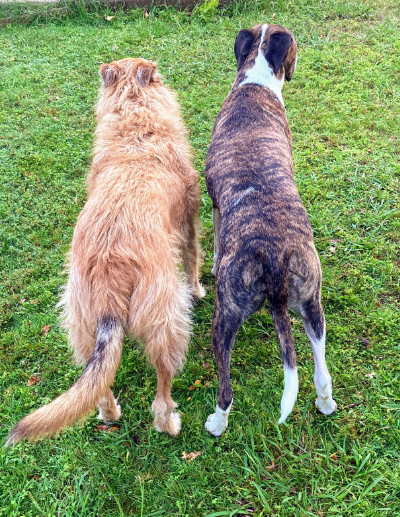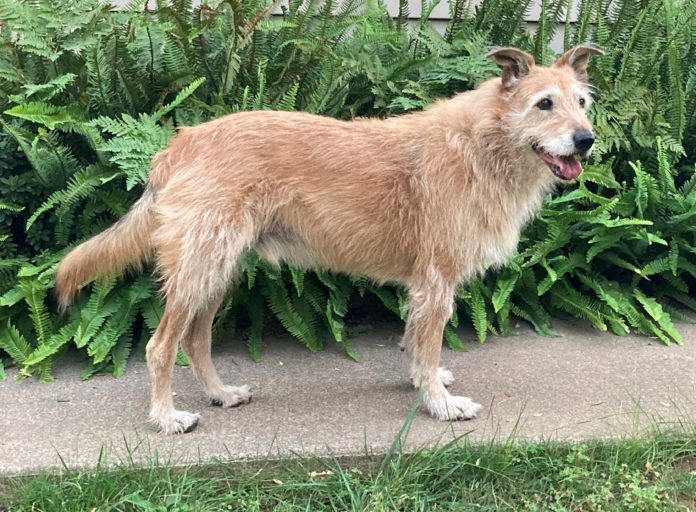Over the past two years, my senior dog, Otto, has started having trouble maintaining his body mass at a healthy weight. He has had a few health issues that his veterinarians and I are monitoring, but one symptom of his issues has caused him to suffer from a bit of gastric reflux. We have been able to keep his stomach acid in check with a daily medication, but there was a period of months when he just didn’t feel like eating. During that time, I had to tempt his appetite with all sorts of foods, split into many small meals a day, to get him to eat at all. At his lowest, his weight, normally about 70 pounds, dipped all the way down to 63 pounds. He felt ribby and definitely lost muscle mass.
Eventually, the tide turned and Otto started eating again, although it was a challenge to get him back up to his “college” weight of 70 pounds. I can’t give him huge meals – he won’t eat a ton in one sitting – so I often give him three meals a day. He also gets canned food mixed into his dry food at each meal, and eats more than a can a day. I also mix some warm water into his food and stir the canned food in, so he doesn’t pick out the canned food and leave any kibble behind.
One unfortunate side effect of the campaign to get Otto to gain and hold his weight: My younger dog Woody has gained too much weight! Because when he sees the canned food come out, he (quite understandably) wants some, too. I don’t have to, of course, but I stir about a teaspoonful of the canned food into Woody’s kibble, and add warm water to it, so he feels like he’s getting special treatment, too. So, of course, I’ve had to cut back the amount of kibble he gets, just a little bit, to make up for the addition of the fattier canned food.

At age 5, Woody is in the prime of his life. He is carrying a few more pounds than I would like, even though it is hard to see given his deep chest and narrow waist. But his ribs are more padded than what is ideal. He is such an active dog that carrying extra weight stresses his joints more than is good for him.
It’s nuts: Both dogs used to weigh the same amount. To get and keep Otto at 70 pounds, I’ve added nearly an entire can of food to what he gets each day, and have had to reduce Woody’s portion of dry food to make up for the addition of only a teaspoon of canned food, and yet Woody is up to about 73 or 74 pounds.

It’s hard to get two dogs to stand with their backs to you while you hover over them, but I did my best. As you can see, both dogs look okay – but Otto’s waist is a bit more pronounced, and Woody’s is less defined than ever before.
I know it’s silly to feel as though Woody would judge me for failing to add anything “nice” to his kibble at each meal, and yet, I absolutely see him watching me carefully when I prepare both dogs’ meals. I actually fork the wet food from the cans into the dogs’ bowls with my back blocking his view, so he can’t see how much of the delicious pâté goes into each bowl, and I deliver the food to them separately. Otto eats outside, with his bowl on a stair that’s one step higher than the deck; Woody eats in the house.
Another wrinkle: Since Coronavirus has changed the world, we definitely have been going out less. The lack of walks has likely contributed both to Otto’s loss of muscle mass and Woody’s weight gain.
Also, I give Otto a pill each day hidden in a piece of cheese. Woody, too, lines up and sits politely, looking for his cheese. Those extra calories, too, aren’t helping me maintain his figure!
Have you had this problem before? Trying to keep one dog thin and helping another dog gain weight? Do you have any tips for us?







We’ve dealt with this for years. Our previous “pack” had 1 healthy dog and 2 dogs with IBD in it, so for years, we bought 2 entirely separate “menus” for them. That included different types of prep. 3 times a day.
The 2 dogs that live with us now are healthy, but different in size and nutrition requirements. We feed them twice a day. We’ve found foods that each of them like and that meet their nutrition requirements. We also measure out what they get at each meal (different for each dog). The foods are different. That’s just the easiest way for us to manage their weight. But they eat at the same time (twice a day) and they get their lunch “treats” at the same time. That helps.
The only thing we have to deal with that breaks this routine is on Sundays when they’re in church. Everybody brings them treats, so we go a little light with their breakfast and dinner on Sundays.
I have a similar problem with a 12.5 year old Catahoula. I’d be very interested in what you’re feeding Otto, and any tips on restoring muscle mass.
The problem is that acid reflux is actually caused by low stomach acid. Giving your dog an acid blocker will make the problem worse. It doesn’t make sense that the majority of veterinarians and medical doctors have not yet gotten the memo on this. It’s heartbreaking that many humans and animals are made to suffer because Big Pharma continues to brainwash well-meaning veterinarians and MD’s to further their financial gain.
So what should we be doing for these dogs instead?
My oldest dog started throwing up bile around 6:00 a.m. in the morning, after not having eaten since dinner at 5:30 p.m. So I save a couple of spoonfuls of her dinner and give them to her at bedtime — 10:30 p.m. This seems to have solved the problem.
That’s what I do for my old guy too.
I have that problem — different age dogs with different metabolisms. i substitute green beans (frozen, no salt or other things) for a portion of their meal — limited calories, bit of extra fiber. each dog sees something “special” going in their bowl and is happy.
I feed raw that I weigh, so it is easy to adjust amounts. I had an older Boston with Addison’s Disease that lost a lot of muscle mass and my sister’s elderly dog is currently losing muscle mass. It would be great to slow that down.
Our Siberian Husky got very picky with her food and had bouts of loud stomach growling with occasional diarrhea. She ate less and less. Within 6 months she stopped eating entirely and the diarrhea was frequent. We tried different foods but nothing worked. We spent way too much money on expensive tests and a biopsy. It was severe IBD. We tube fed her for 3 months but she kept losing weight, then weakness caused falling. When the uncontrollable diarrhea turned bloody, we made the hard decision. Since then I’ve read that foods with a high percentage of pea protein can cause problems in dogs. Her regular food for years had pea protein as a major ingredient (listed 2nd on the label). We try not to feel guilty (and the vets would never say it) but I think pea protein killed our sweet dog. We don’t geed our new dog pea protein at all.
I feed ¼ cup of kibble, 3 heaping teaspoons of canned. In the morning I add can no salt green beans and carrots. Was using raw carrots but that seems to come out in her stool. I also, in the morning, cut Cucumber into very small pieces. She doesn’t seem to devour that as quickly as she use to but, if left, goes back. Her weight, with less walks due to my own surgery, has put a little weight on. She’s an Australian Terrier. Should weigh 19-20 but probably borders 22 now. Any suggestions. 8 years old.
Hey Mary Lou … I have two AT’s, one has had two surgeries in the past year so have had to work at keeping him trim. Because they are not big dogs it’s tough to cut back food when they don’t seem to get much! We have started lots of “slow feeding” with snuffle mats, kongs and licki mats. Seems to help and keeps them busy.
Dogs can’t break down the cellulose in raw vegetables. That’s why the carrots come out the same way they went. They either have to be gently cooked (steamed is great) or if left raw pureed.
I once read of a conversation between a vet and an older woman. The vet remarked how her dogs were always looking good and their weight was close to ideal. He asked her how she did it. She said, “When they look a little heavy, I feed a little less and when they look a little skinny, I feed a little more.” Stupid, but so simple. It is what I do. I have 3 dogs, and used to have 4. I feed 2 at the same time. One gets a little more then the other, but they don’t notice. If I have to give special attention to one, I simply feed one, let them out, then feed the other. I used to hide pills in cheese, but went to deli sliced meat, because it was easier to conceal.
Now, if I could stop them from eating poop, I would be happy. I know, keep it picked up, but with these dogs I would have to hold a shovel under their butts!
Good luck with Otto. I hope he continues to get better.
We moved to the country a few months ago. My two Golden’s don’t eat their own poop but they love to scarf up the deer, goose, and turkey poop! Drives us crazy! We pick up what is in our yard but when walking we’re always telling them to stop eating.
There is an erroneous theory going around that gastric reflux in both people and dogs is caused by low stomach acid. GERD is caused by one of two things or often a combination – a higher than normal amount of stomach acid and/or a weak lower esophageal sphincter. Both my dog & I have it verified by medical tests that measured the amount of gastric acid we produced. Medication, small, frequent meals, nothing to eat three hours before bedtime, & avoiding certain foods have gotten our problems under control.
I have 4 pups ranging from 3 months to 13 yrs. I sit with them on the patio while they eat. Some are picky , some love to eat. What canned do you mix in your kibble?
I have a lurcher and to keep his weight on I added coconut oil along with fish oil to his diet of separate raw and kibble meals. So far he is maintaining unless I reach his threshold for anxiety then I need to increase his overall food/calorie intake. I do find he can only eat so much volume during the day otherwise it just comes out the back end.
Raw food solves all problems…you have total control of what goes into your dog’s meals and can adjust as necessary Throw out the kibble. Titers instead of automatic vaccinations. Essential oils instead of flea and tick medications and figure the odds of your dog contacting Heart Worm before giving them a dose that is unnecessary.
Canned food is mostly water and if you follow The Whole Dog Journal you know that “pea protein” is empty calories.
I second the raw food recommendation.. I supplement it with Honest Kitchen dehydrated to keep the cost down. My 11 year old coonhound has put on a bit of weight during COVID even though we are walking 5 miles a day. She gets lots of small treats during walks for training. Now I’m cutting back on her meals to make up for it.
Have you considered getting both dogs off kibble and canned dog food? That would be my first step.
I had this problem with Ramses starting about 18 months before he passed.
My vet also thought it might be acid reflux and put him on the same meds I take, only he got over the counter. That and smaller meals spaced out during the day helped a bit.
I also starting supplementing with canned food. For a while I also would cook up some freezer-burned roasts that were a bit too old for me but he thought were delicious.
I was able to put some weight back on him but after the removal of a tumor he was off his feed again. I started him on cannabis oil and that helped a bit with his appetite and likely a bit with his pain too. Also giving him turmeric and cinnamon and fish oil. I had been supplementing with fish oil for years. I added probiotics when he went on the omeprazole.
What also helped was keeping him on the pain meds he had after surgery and eventually increasing them.
After he finally got the x-ray I had wanted it was found he had disc problems in his back. No wonder he wasn’t eating well, he must have been in such pain. Meds were increased again.
But the x-rays also showed that he had bone cancer in his pelvis so it was only a matter of time. I wish they had done the x-rays sooner when I wanted. I could have increased his meds earlier and started to spoil him sooner so he might not have lost as much weight.
He did start losing weight again but I did manage to keep him eating. He got many treats as at that point it didn’t matter if he gained weight. That would have been a plus. So I used cheese and hot dogs and all sorts of goodies to hide his pills in. And whatever I ate he got a bit so hamburger, steak, chicken, he shared it all. He also ate fruit and vegetables.
His college weight was 55 most of his life but he was down to 43 near the end. He died in his sleep two days before our final vet appointment. Thanksgiving night. 14 years and 9 months. The day before was one of his better days. We visited my parents and he and their dog went around the neighborhood on their regular walk, saying goodbye and sniffing and even prancing a bit. It was like he knew and was enjoying a last fling.
He was a great dog and quite the gentleman. No bad habits like humping or toilet bowl drinking or trash digging and his kisses were the faintest of flicks; you didn’t feel moisture. He was protective and often on alert but not obnoxiously so. Training was a breeze and he walked off leash beautifully and always recalled immediately. He loved to swim. He looked like Anubis except his tail was fluffier.
I do something similar to Randy — eyeball my two dogs (Border Collies) and adjust food accordingly. I do “ditch the bowl,” so the dogs get most of their food in training sessions or as behavioral aides, or occasionally as a calming chew. This works fairly well, but is made little difficult since one of my dogs loves training and loves to eat, while the other is finicky about eating and would much rather have non-food reinforcers. So, I have been consciously working on getting the finicky one more food motivated, and also being more generous in the quantity or size of treats with him when we are training with food. I also sometimes give extra food to him out of sight of the other (who like Woody watches my food dispensing like a hawk–judging quantity and quality with the precision of an accountant!)
I would try a species appropriate diet (raw) and stop kibble’s;e and canned.
My dog eat kibble’s that’s the only one he can eat he don’t like any other one…
My dogs eat half kibble and half home prepared “glop” which is made from grass fed meats, veggies and fruit which we prepare daily. I also add salmon oil, and natrures farmacy pre/probiotics for gastric health. The dogs are in fantastic health with beautiful, shiny coats!!
Can you give us an idea of what makes up the home prepared “glop”? What type of meat, veggies and fruit do you
include? I would like to give this a try.
Thank you!
sbatteiger@gmail.com
I felt like my lab also had an avoid stomach. Her GI Tracy was so growly in the morning that you could hear it across the room, plus it woke her up too early. I did the same as others had done, I split her dinner in 2, half At 6 pm, the other half at 10 pm. No more growly GI tract and no more waking up early. Every body is much happier!
This is actually an awesome articles. Much obliged to you for sharing this.I would love to see some more websites from you later on. I have some great adornments. I trust you will likewise love to see them. I am sharing the site connect with you.